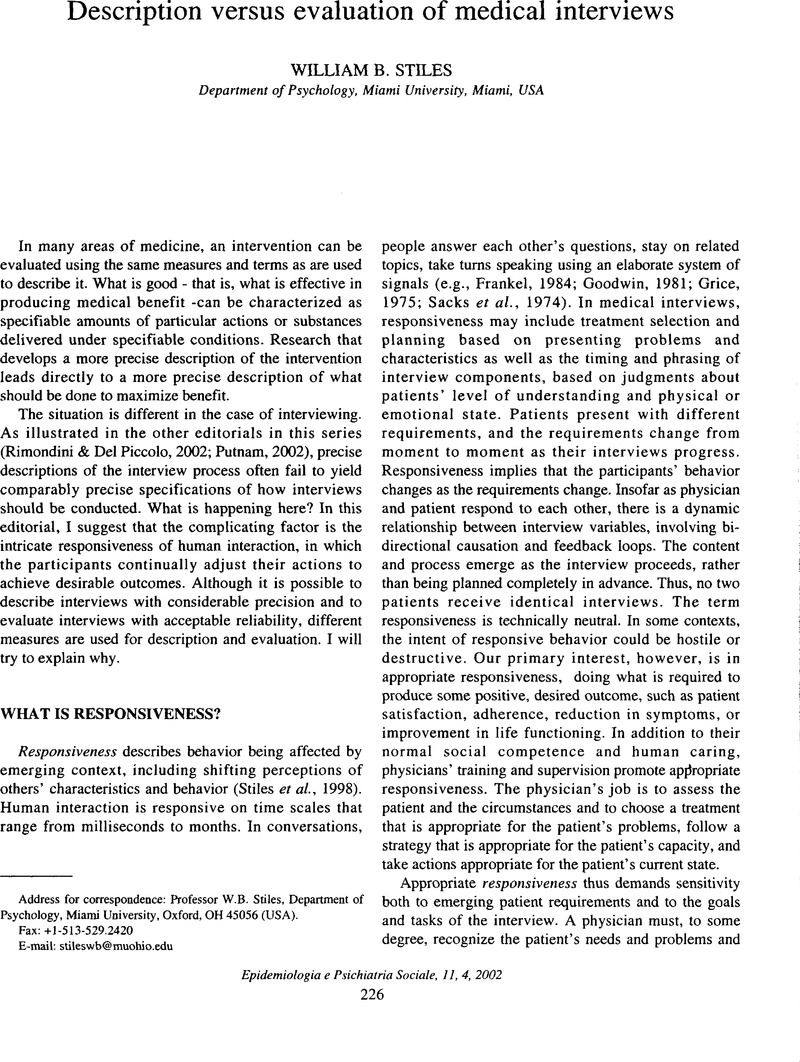Crossref Citations
This article has been cited by the following publications. This list is generated based on data provided by Crossref.
Meeuwesen, Ludwien
2003.
Sequential analysis of the phasing of the medical interview.
Epidemiologia e Psichiatria Sociale,
Vol. 12,
Issue. 2,
p.
124.
Zimmermann, Christa
Piccolo, Lidia Del
and
Mazzi, Maria Angela
2003.
Patient cues and medical interviewing in general practice: examples of the application of sequential analysis.
Epidemiologia e Psichiatria Sociale,
Vol. 12,
Issue. 2,
p.
115.
Krupat, Edward
Frankel, Richard
Stein, Terry
and
Irish, Julie
2006.
The Four Habits Coding Scheme: Validation of an instrument to assess clinicians’ communication behavior.
Patient Education and Counseling,
Vol. 62,
Issue. 1,
p.
38.
Meeuwesen, Ludwien
Tromp, Fred
Schouten, Barbara C.
and
Harmsen, Johannes A.M.
2007.
Cultural differences in managing information during medical interaction: How does the physician get a clue?.
Patient Education and Counseling,
Vol. 67,
Issue. 1-2,
p.
183.
Price, Eboni G.
Windish, Donna M.
Magaziner, Jeffrey
and
Cooper, Lisa A.
2008.
Assessing validity of standardized patient ratings of medical students’ communication behavior using the Roter interaction analysis system.
Patient Education and Counseling,
Vol. 70,
Issue. 1,
p.
3.
Ge Gao
Burke, Nancy
Somkin, Carol P.
and
Pasick, Rena
2009.
Considering Culture in Physician— Patient Communication During Colorectal Cancer Screening.
Qualitative Health Research,
Vol. 19,
Issue. 6,
p.
778.
Gavilán Moral, Enrique
Ruiz Moral, Roger
Perula de Torres, Luis Ángel
and
Parras Rejano, Juan Manuel
2010.
Valoración de la relación clínica centrada en el paciente: análisis de las propiedades psicométricas de la escala CICAA.
Atención Primaria,
Vol. 42,
Issue. 3,
p.
162.
McCormack, Lauren A.
Treiman, Katherine
Rupert, Douglas
Williams-Piehota, Pamela
Nadler, Eric
Arora, Neeraj K.
Lawrence, William
and
Street, Richard L.
2011.
Measuring patient-centered communication in cancer care: A literature review and the development of a systematic approach.
Social Science & Medicine,
Vol. 72,
Issue. 7,
p.
1085.
Dahlin, Marie
Söderberg, Stina
Holm, Ulla
Nilsson, Ingrid
and
Farnebo, Lars-Ove
2012.
Comparison of communication skills between medical students admitted after interviews or on academic merits.
BMC Medical Education,
Vol. 12,
Issue. 1,
Matusitz, Jonathan
and
Spear, Jennifer
2015.
Doctor-Patient Communication Styles: A Comparison Between the United States and Three Asian Countries.
Journal of Human Behavior in the Social Environment,
Vol. 25,
Issue. 8,
p.
871.
Abe, Tetsuya
Nishiyama, Junji
Kushida, Shuya
Kawashima, Michie
Oishi, Naoko
and
Ueda, Kento
2023.
Tailored opening questions to the context of using medical questionnaires: Qualitative analysis in first‐visit consultations.
Journal of General and Family Medicine,
Vol. 24,
Issue. 2,
p.
79.





